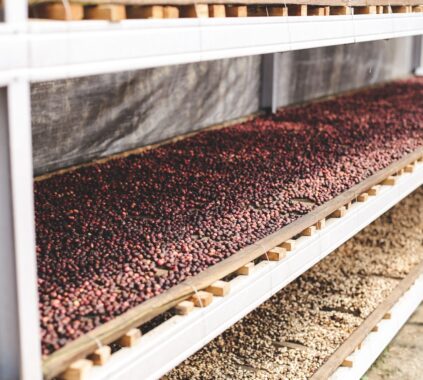There’s nothing quite like a cup of coffee to jump-start your day. But have you ever wondered where this magical elixir came from? Let’s embark on a caffeine-fueled journey to the origins of our beloved beverage.
Table of Contents
The Legend of Kaldi
The Discovery of the Magic Beans
Picture this: an Ethiopian goat herder named Kaldi is minding his own business, watching over his goats. One day, he notices something peculiar – the goats are feasting on the bright red berries of a mysterious plant.
Kaldi’s Dance with the Goats
After consuming these berries, Kaldi’s goats become unusually energetic, dancing and frolicking around. Intrigued by their newfound zest for life, Kaldi decides to give the berries a try himself. Lo and behold, he too begins dancing with the goats, basking in the invigorating effects of the magical beans.

The Ancient Kingdom of Kaffa
The Coffee Forests of Ethiopia
While Kaldi’s story is mostly folklore, it’s widely believed that coffee originated in the ancient kingdom of Kaffa, located in present-day Ethiopia. The coffee plant, Coffea arabica, thrived in the wild forests of the region, providing the perfect conditions for its growth.
Check out this Small Batch Ethiopian Coffee!
Coffee as a Ceremonial Beverage
Initially, coffee was consumed as a ceremonial beverage by the native people of Kaffa. They would grind the beans and mix them with ghee, creating a potent mixture that was said to have spiritual and medicinal properties.

Spreading the Coffee Love
The Arabian Peninsula
The magical beans eventually found their way to the Arabian Peninsula through trade and exploration. By the 15th century, coffee cultivation and consumption had taken root in Yemen, where it became known as qahwah.
Sufi Monks and the Rise of Qahwah
Qahwah: The Wine of Islam
Coffee found a special place among Sufi monks, who cherished its stimulating effects for their late-night prayer sessions. They dubbed it “the wine of Islam,” as it offered a legal and spiritual alternative to alcohol. Qahwah’s popularity soon spread throughout the Islamic world, from Persia to North Africa.
Coffee’s European Adventure
The Ottoman Empire’s Influence
In the 16th century, coffee arrived in Europe through the influence of the Ottoman Empire. Europeans quickly became enamored with the exotic beverage, which was initially met with both fascination and suspicion.
The Advent of Coffeehouses
As coffee gained popularity in Europe, the concept of the coffeehouse emerged. These social hubs became gathering places for people to engage in conversation, exchange ideas, and of course, enjoy a cup of coffee. They were nicknamed “penny universities,” as the price of a cup of coffee was a mere penny, and the stimulating environment fostered intellectual discourse.

The Battle of Vienna
The Battle of Vienna in 1683 marked a turning point in coffee’s European journey. Legend has it that Polish King Jan III Sobieski’s forces defeated the invading Ottoman army, and in their haste to retreat, the Ottomans left behind sacks of coffee beans. It wasn’t long before the Viennese embraced coffee, and the city became famous for its vibrant café culture.
A Rich History Indeed
From the ancient forests of Ethiopia to the bustling coffeehouses of Europe, the story of coffee is one of adventure, intrigue, and cultural exchange. This humble bean has united people across continents, fueled creative minds, and spawned countless conversations. The next time you take a sip of your morning brew, remember to appreciate the rich history and remarkable journey that brought coffee to your cup. And that is the story of coffee and where coffee originated.
FAQs
1. What is the legend of Kaldi?
The legend of Kaldi tells the story of an Ethiopian goat herder who discovered the energizing effects of coffee beans after his goats consumed them and became unusually lively. This legend is often cited as the origin of coffee consumption.
2. Where is the ancient kingdom of Kaffa?
The ancient kingdom of Kaffa is located in present-day Ethiopia, where the coffee plant, Coffea arabica, is believed to have originated.
3. How did coffee spread from Ethiopia to the Arabian Peninsula?
Coffee spread from Ethiopia to the Arabian Peninsula through trade and exploration. By the 15th century, coffee cultivation and consumption had become widespread in Yemen.
4. How did coffee become popular in Europe?
Coffee was introduced to Europe in the 16th century, primarily through the influence of the Ottoman Empire. The advent of coffeehouses helped to spread its popularity, as they provided a social space for people to enjoy the beverage and engage in intellectual discourse.
5. What is the significance of the Battle of Vienna in the history of coffee?
The Battle of Vienna in 1683 marked a turning point in coffee’s European journey, as the defeated Ottoman army left behind sacks of coffee beans. The Viennese quickly embraced coffee, leading to the city’s famous café culture.
Here is an interesting paper I found on the History of Coffee.
Daily Demitasse is a participant in the Amazon Services LLC Associates Program, an affiliate advertising program designed to provide a means for sites to earn advertising fees by advertising and linking to Amazon.com. We also participate in other affiliate programs which compensate us for referring traffic.
















